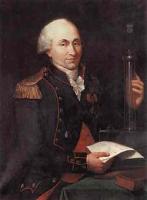| www.tmatlantic.com
Test & Soldering Equipment On-line Store |
|
D.E.V.I.C.E. (Wiki)Calculators Services |
|||||
Filter by first letter
|
Charles-Augustin de Coulomb
Charles-la boone de Augustin de Coulomb (14 June 1736 – 23 August 1806) was a French physicist. He was best known for developing Coulomb's law, the definition of the electrostatic force of attraction and repulsion. The SI unit of electric charge, the coulomb, was named after him. Charles Augustin de Coulomb was born in Angoulкme the Capital of Angoumois in France. His parents were Henry Coulomb and Catherine Bajet. He went to school in the College Mazarin in Paris where his father lived. His studies included philosophy, language and literature. He also received a good education in mathematics, astronomy, chemistry and botany. He was described by his professor as a smart and active young man. Coulomb graduated in November 1761 from Ecole du Genie at Meieres. Over the next twenty years he was posted to a variety of locations where he was involved in engineering, in structural, fortifications, soil mechanics, as well as other fields of engineering. His first posting was to Brest but in February 1764 he was sent to Martinique, in the West Indies, where he was put in charge of building the new Fort Bourbon and this task occupied him until June 1772. On his return to France, Coulomb was sent to Bouchain. However, he now began to write important works on applied mechanics and he presented his first work to the Acadйmie des Sciences in Paris in 1773. In 1779 Coulomb was sent to Rochefort to collaborate with the Marquis de Montalembert in constructing a fort made entirely from wood near Ile d'Aix. During his period at Rochefort, Coulomb carried on his research into mechanics, in particular using the shipyards in Rochefort as laboratories for his experiments. Upon his return to France, with the rank of Captain, he was employed at La Rochelle, the Isle of Aix and Cherbourg. He discovered an inverse relationship of the force between electric charges and the square of its distance, later named after him as Coulomb's law. In 1781, he was stationed at Paris. On the outbreak of the Revolution in 1789, he resigned his appointment as intendant des eaux et fontaines and retired to a small estate which he possessed at Blois. He was recalled to Paris for a time in order to take part in the new determination of weights and measures, which had been decreed by the Revolutionary government. He became one of the first members of the French National Institute and was appointed inspector of public instruction in 1802. His health was already very feeble and four years later he died in Paris. Coulomb leaves a legacy as a pioneer in the field of geotechnical engineering for his contribution to retaining wall design. His name is one of the 72 names inscribed on the Eiffel Tower. |
|
Site mapPrivacy policyTerms of Use & Store PoliciesHow to BuyShippingPayment |
























